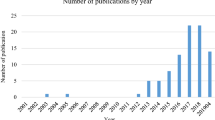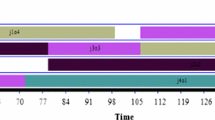Abstract
In the past three decades many studies have been carried out on cellular manufacturing. The main problem in the development of cellular manufacturing is that of machine cell formation. In this paper a new metaheuristic called a memetic algorithm (MA) is introduced to solve the machine cell formation problem in group technology. The objective functions considered in this work are (a) minimization of total number of moves and (b) minimization of cell load variation and the constraints considered are minimum number of machines in each cell as two and each machine should be assigned in one cell only. Effort has been made to develop an algorithm that is more reliable than conventional methods and some non-traditional optimization techniques like the genetic algorithm (GA) and the tabu search algorithm (TS) for solving machine cell formation problem. In the memetic algorithm approach local optimization is applied to each newly generated offspring at the end of genetic algorithm.
Similar content being viewed by others
References
Vakharia AJ (1986) Methods of cell formation in group technology: a framework for evaluation. J Oper Manage 6(3):257–271
Opitz H (1970) A classification system to describe work pieces. Pergamon, New York
Burbidge L (1963) Production flow analysis. Prod Eng 42:742–752
King JR (1980) Machine-component grouping in production flow analysis; an approach using a rank order-clustering algorithm. Int J Prod Res 18(2):213–232
Chan HM, Milner DA (1982) Direct clustering algorithm for group formation in cellular manufacture. J Manuf Syst 1(1):64–76
McCormick WT, Schweitzer RJ, White TW (1972) Problem decomposition and data reorganization by clustering techniques. Oper Res 20:993–1009
McAuley J (1972) Machine grouping for efficient production. Prod Eng 15:53–57
Seifoddini H, Wolfe P (1990) Application of similarity coefficient methods in GT. IIE Trans 18(3):271–277
Rajagopalan R, Batra JL (1975) Design of cellular production systems – a graph theory approach. Int J Prod Res 13(6):567–579
Boctor FF (1991) A linear formulation of the machine-part cell formation problem. Int J Prod Res 29(2):343–356
Vakharia AJ, Chang YL (1997) Cell formation in group technology: a combinatorial search approach. Int J Prod Res 35(7):2025–2043
Steudle H, Ballakur A (1987) A dynamic programming based heuristic for machine grouping in manufacturing cell formation. Comput Ind Eng 12(3):215–222
Shafer S, Rogers D (1991) A goal programming approach to the cell formation problem. J Oper Manage 10(1):28–43
Chen WH, Srivstava B (1994) Simulated annealing procedures for forming machine cell in-group technology. Eur J Oper Res 75(1):100–111
Venugopal V, Narendran TT (1992) Cell formation in manufacturing systems through simulated annealing; an experimental evaluation. Eur J Oper Res 63:409–422
Venugopal V, Narendran TT (1992) A genetic algorithm approach to the machine–component grouping problems with multiple objectives. Comput Ind Eng 22(4):469–480
Logendran R, Ramakrishna P (1995) Manufacturing cell formation in the presence of lot splitting and multiple units of the same machine. Int J Prod Res 31:657–693
Asokan P, Prabhakaran G, Satheesh KG (2001) Machine cell grouping in cellular manufacturing systems using nontraditional optimization techniques – a comparative study. Int J Adv Manuf Technol 18:140–147
Basu A, Hyer N, Shtub A (1995) An expert system based approach to manufacturing cell design. Int J Prod Res 33(10):2739–2755
Chow W, Hawaleshka O (1993) A novel machine grouping and knowledge based approach for cellular manufacturing. Eur J Oper Res 69:357–372
Singh N, Rajamaani D (1996) Cellular manufacturing systems design planning and control. Chapman and Hall, New York
Selim HM, Askin RG, Vakharia AJ (1998) Cell formation in group technology evaluation and directions for future research. Comput Ind Eng 34(1):3–20
Chen C, Cotruvo N Back (1995) A simulated annealing solution to the cell formation problem. Int J Prod Res 33(9):2601–2614
Guptha Y, Guptha M, Kumar A, Sundram C (1995) Minimization of total intercell and intra cell moves in cellular manufacturing: a genetic algorithms. Int J Comput Integr Manuf 8(2):92–101
Joines JA, Culbreth CT, King RE (1996) Manufacturing cell design an integer programming model employing genetic algorithms. IIE Trans 28(1):69–85
Logendran R, Ramakrishnan P, Srikandarajah C (1994) Tabu search based heuristics for cellular manufacturing system in the presence of alternative process plans. Int J Prod Res 32(2):273–297
Moscato P, Norman MG (1992) A memetic approach for the traveling salesman problem – implementation of a computational ecology for combinatorial optimization on message-passing systems. Proceedings of the International Conference on Parallel Computing and Transporter Applications, IOS Press, Amsterdam, pp 187–194
Radcliffe NJ, Surry PD (1994) Formal memetic algorithms. In: Fogarty TC (ed) Lecture notes in computer science (Lecture notes in evolutionary computing), vol 865. Springer, Berlin Heidelberg New York, 865:250–263
Glover F (1989) Tabu search, part I. ORSA J Comput 1:190–206
Glover F (1990) Tabu search, part II. ORSA J Comput 2:4–32
Aljaber N, Baek W, Chen C-L (1997) A tabu search approach to the cell formation problem. Comput Ind Eng 32(1):169–185
Sun D, Lin L, Batta R (1995) Cell formation using tabu search. Comput Ind Eng 28(3):485–494
Author information
Authors and Affiliations
Corresponding author
Rights and permissions
About this article
Cite this article
Muruganandam, A., Prabhaharan, G., Asokan, P. et al. A memetic algorithm approach to the cell formation problem. Int J Adv Manuf Technol 25, 988–997 (2005). https://doi.org/10.1007/s00170-003-1912-7
Received:
Accepted:
Published:
Issue Date:
DOI: https://doi.org/10.1007/s00170-003-1912-7




